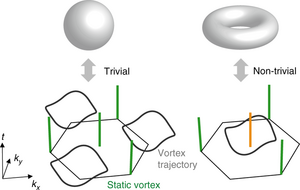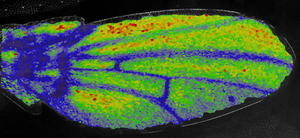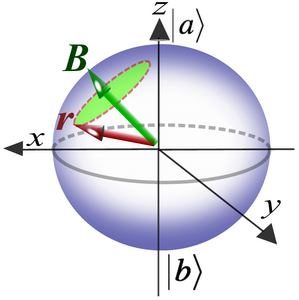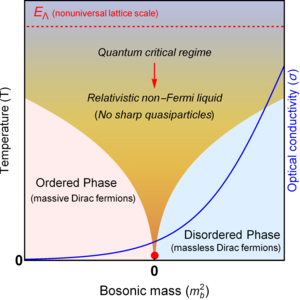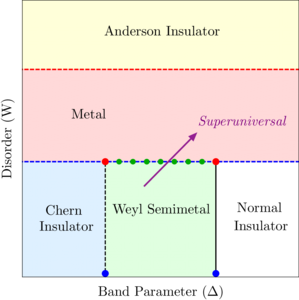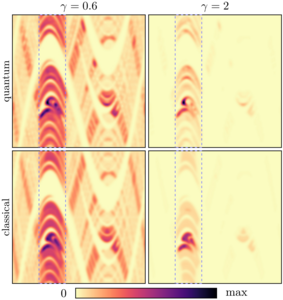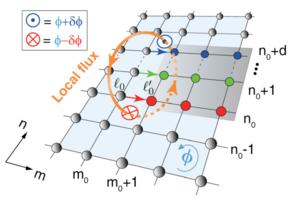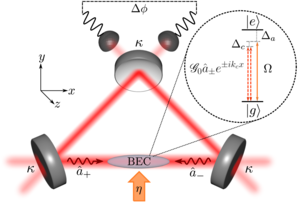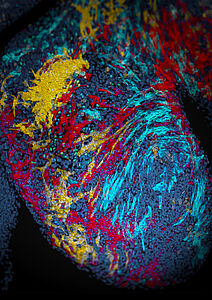
Archived Publication Highlights
Publication Highlights
Measuring topology from dynamics by obtaining the Chern number from a linking number
Integer-valued topological indices, characterizing nonlocal properties of quantum states of matter, are known to directly predict robust physical properties of equilibrium systems. The Chern number, e.g., determines the quantized Hall conductivity of an insulator. Using non-interacting fermionic atoms in a periodically driven optical lattice, scientists from the University of Hamburg and the MPIPKS in Dresden have demonstrated experimentally that the Chern number determines also the far-from-equilibrium dynamics of a quantum system. Namely, it dictates the linking number of the trajectories of momentum-space vortices, as they emerge after an abrupt change of system parameters.
M. Tarnowski et al., Nat. Commun. 10, 1728 (2019)
Read moreM. Tarnowski et al., Nat. Commun. 10, 1728 (2019)
Publication Highlights
Quantum localization bounds Trotter errors in digital quantum simulation
Quantum computers promise to solve certain computational problems exponentially faster than any classical machine. A particularly promising application is the solution of quantum many-body problems utilizing the concept of digital quantum simulation. A fundamental challenge, however, is the control of an intrinsic error source, which appears due to the utilized time discretization. Here, we show that quantum localization-by constraining the time evolution through quantum interference-strongly bounds these errors for local observables. Digital quantum simulation is thus intrinsically much more robust than expected from known global error bounds.
M. Heyl et al., Science Advances 5, eaau8342 (2019)
Read moreM. Heyl et al., Science Advances 5, eaau8342 (2019)
Publication Highlights
How tissues respond to mechanical stress
Underlying mechanism of cell viscoelasticity revealed
Epithelial tissues like our skin are made of cells that are tightly connected through E-Cadherin – a protein that binds adjacent cells together. These tissues respond differently to forces from the environment. When they are subjected to forces for a short duration they behave like an elastic band, whereas, when subjected to the same force for a longer duration they show viscous behavior like honey. This property of tissues, called viscoelasticity, plays a key role to understand tissue shape changes during embryonic development. Although viscoelasticity is a well-known property, the molecular mechanisms underlying such viscoelastic behavior of developing tissues were largely unknown, so far.
Read moreEpithelial tissues like our skin are made of cells that are tightly connected through E-Cadherin – a protein that binds adjacent cells together. These tissues respond differently to forces from the environment. When they are subjected to forces for a short duration they behave like an elastic band, whereas, when subjected to the same force for a longer duration they show viscous behavior like honey. This property of tissues, called viscoelasticity, plays a key role to understand tissue shape changes during embryonic development. Although viscoelasticity is a well-known property, the molecular mechanisms underlying such viscoelastic behavior of developing tissues were largely unknown, so far.
Publication Highlights
Measuring the single-particle density matrix in an optical lattice
L. A. Peña Ardila et al., Phys. Rev. Lett. 121, 260401 (2018)
Ultracold atoms in optical lattices provide clean, tunable, and well-isolated realizations of paradigmatic quantum lattice models. With the recent advent of quantum-gas microscopes, they now also offer the possibility to measure the occupations of individual lattice sites. What, however, has not yet been achieved is to measure those elements of the single-particle density matrix, which are off-diagonal in the occupation basis. Here, we propose a scheme to access these basic quantities both for fermions as well as hard-core bosons and investigate its accuracy and feasibility.
Read moreUltracold atoms in optical lattices provide clean, tunable, and well-isolated realizations of paradigmatic quantum lattice models. With the recent advent of quantum-gas microscopes, they now also offer the possibility to measure the occupations of individual lattice sites. What, however, has not yet been achieved is to measure those elements of the single-particle density matrix, which are off-diagonal in the occupation basis. Here, we propose a scheme to access these basic quantities both for fermions as well as hard-core bosons and investigate its accuracy and feasibility.
Publication Highlights
Collisionless Transport Close to a Fermionic Quantum Critical Point in Dirac Materials
B. Roy et al., Phys. Rev. Lett. 121, 137601 (2018)
Dirac fermions are realized as low-energy excitations in a wide class of condensed matter systems, such as graphene and surface states of topological insulators. These so-called Dirac materials are rather stable against weak Hubbard-like local interactions. However, at strong interactions they may undergo quantum phase transitions into broken symmetry phases, such as spin- and charge-density-waves. The question then arises what may be the possible experimental imprints of such a quantum phase transition in terms of observable. Researcher from MPIPKS in collaboration with Nordita recently showed that the frequency-dependent electrical conductivity at both zero and finite temperature gets suppressed in the close vicinity to such critical point in comparison to its counterpart in a noninteracting system. Such peculiar, but universal behavior stems from strong interactions among wildly fluctuating gapless fermionic and bosonic order-parameter excitations inside the quantum critical regime, occupied by a relativistic non-Fermi liquid.
Read moreDirac fermions are realized as low-energy excitations in a wide class of condensed matter systems, such as graphene and surface states of topological insulators. These so-called Dirac materials are rather stable against weak Hubbard-like local interactions. However, at strong interactions they may undergo quantum phase transitions into broken symmetry phases, such as spin- and charge-density-waves. The question then arises what may be the possible experimental imprints of such a quantum phase transition in terms of observable. Researcher from MPIPKS in collaboration with Nordita recently showed that the frequency-dependent electrical conductivity at both zero and finite temperature gets suppressed in the close vicinity to such critical point in comparison to its counterpart in a noninteracting system. Such peculiar, but universal behavior stems from strong interactions among wildly fluctuating gapless fermionic and bosonic order-parameter excitations inside the quantum critical regime, occupied by a relativistic non-Fermi liquid.
Publication Highlights
Global Phase Diagram of a Dirty Weyl Liquid and Emergent Superuniversality
B. Roy et al., Phys. Rev. X 8, 031076 (2018)
Weyl semimetals are exotic materials in which electrons behave more like photons - massless particles moving at a relativistic speed. However, it is unclear how well Weyl semimetals hold on to their bizarre properties in real disordered materials that are littered with impurities. Researchers from MPIPKS in collaboration with Nordita show that for small amounts of disorder such gapless topological semiconductors are stable, but at intermediate disorder these systems can undergo a quantum phase transition into a metallic phase, where electrons cease to behave as relativistic particles. Intriguingly, they discovered that the nature of this continuous transition is insensitive to the many (if not all) details of impurities, a phenomenon commonly referred to as superuniversality, which leaves its signature on the behavior of various observables, such as specific heat and electrical conductivity. These features combined with several other known transitions constitute the global phase diagram of disordered Weyl systems.
Read moreWeyl semimetals are exotic materials in which electrons behave more like photons - massless particles moving at a relativistic speed. However, it is unclear how well Weyl semimetals hold on to their bizarre properties in real disordered materials that are littered with impurities. Researchers from MPIPKS in collaboration with Nordita show that for small amounts of disorder such gapless topological semiconductors are stable, but at intermediate disorder these systems can undergo a quantum phase transition into a metallic phase, where electrons cease to behave as relativistic particles. Intriguingly, they discovered that the nature of this continuous transition is insensitive to the many (if not all) details of impurities, a phenomenon commonly referred to as superuniversality, which leaves its signature on the behavior of various observables, such as specific heat and electrical conductivity. These features combined with several other known transitions constitute the global phase diagram of disordered Weyl systems.
Publication Highlights
Resonance eigenfunction hypothesis for chaotic systems
K. Clauß et al., Phys. Rev. Lett. 121, 074101 (2018)
Classical systems with particles escaping through an opening are quantum mechanically described by resonance eigenfunctions. They are for example important for scattering experiments, like emission from optical microcavities, and show fractal patterns which strongly depend on their decay rate. The resonance eigenfunction hypothesis put forward in the paper provides a detailed understanding of this fractal structure. It is based on classical properties of the chaotic dynamics with a new time scale given by the temporal distance to the so-called chaotic saddle. Numerical support is presented for a chaotic map with escape.
Read moreClassical systems with particles escaping through an opening are quantum mechanically described by resonance eigenfunctions. They are for example important for scattering experiments, like emission from optical microcavities, and show fractal patterns which strongly depend on their decay rate. The resonance eigenfunction hypothesis put forward in the paper provides a detailed understanding of this fractal structure. It is based on classical properties of the chaotic dynamics with a new time scale given by the temporal distance to the so-called chaotic saddle. Numerical support is presented for a chaotic map with escape.
Publication Highlights
Floquet Engineering of Optical Solenoids and Quantized Charge Pumping along Tailored Paths in Two-Dimensional Chern Insulators
Botao Wang et al., Phys. Rev. Lett. 120, 243602 (2018)
The adiabatic creation of single quasipartices or quasiholes via the insertion of one magnetic flux quantum through an infinitely thin solenoid is a famous gedanken experiment of quantum-Hall physics. In the present paper, physicists from Dresden show how this scenario can be realized in a real experiment with ultracold atoms in optical lattices. For this purpose, they propose a scheme for engineering "optical solenoids", tunable artificial magnetic fields piercing a single plaquette of an optical lattice. Moreover, they investigate how this technique can be used for quantized charge pumping along tailored paths in two dimensional topological Chern insulators.
Read moreThe adiabatic creation of single quasipartices or quasiholes via the insertion of one magnetic flux quantum through an infinitely thin solenoid is a famous gedanken experiment of quantum-Hall physics. In the present paper, physicists from Dresden show how this scenario can be realized in a real experiment with ultracold atoms in optical lattices. For this purpose, they propose a scheme for engineering "optical solenoids", tunable artificial magnetic fields piercing a single plaquette of an optical lattice. Moreover, they investigate how this technique can be used for quantized charge pumping along tailored paths in two dimensional topological Chern insulators.
Publication Highlights
Driven-Dissipative Supersolid in a Ring Cavity
F. Mivehvar et al., Phys. Rev. Lett. 120, 123601 (2018)
Supersolids, a mysterious phase of matter consisting of a crystal which can flow without friction, have been elusive to experimental confirmation till last year, where the first realisations using ultracold atomic systems have been achieved. These atomic implementations however take place in driven-dissipative systems, a situation which lies outside the?thermal equilibrium scenario so far considered in theory.
In this work, we study for the first time the effect of the openness of the system on the main features of a supersolid, and find that its hallmarks can be robust against drive and dissipation whenever the latter preserve spatial translation invariance.
Read moreSupersolids, a mysterious phase of matter consisting of a crystal which can flow without friction, have been elusive to experimental confirmation till last year, where the first realisations using ultracold atomic systems have been achieved. These atomic implementations however take place in driven-dissipative systems, a situation which lies outside the?thermal equilibrium scenario so far considered in theory.
In this work, we study for the first time the effect of the openness of the system on the main features of a supersolid, and find that its hallmarks can be robust against drive and dissipation whenever the latter preserve spatial translation invariance.
Publication Highlights
Universality of clone dynamics during tissue development
S. Rulands et al., Nature Physics (2018)
The development of an organism relies on the tightly orchestrated behavior of many cells. How do these cells self-organize in order to build complex structures like the heart or the brain? To achieve this the fate of these cells must be precisely regulated and understanding the mechanisms of cell fate regulation is key for treating diseases that occur upon dysregulation, such as cancer or diabetes. The fate behaviour of stem and progenitor cells is reflected in the time evolution of their progeny, termed clones, which serve as a key experimental observable. But what can we actually learn from such clones about the processes that regulate their fate during development? Drawing on the results of genetic tracing studies, we show that, despite the complexity of organ development, clonal dynamics may converge to a critical state characterized by universal scaling behaviour of clone sizes. We show how this identification of universal scaling dependences may allow lineage-specific information to be distilled from experiments. Our study shows the emergence of core concepts of statistical physics in an unexpected context, identifying cellular systems as a laboratory to study non-equilibrium statistical physics.
Read moreThe development of an organism relies on the tightly orchestrated behavior of many cells. How do these cells self-organize in order to build complex structures like the heart or the brain? To achieve this the fate of these cells must be precisely regulated and understanding the mechanisms of cell fate regulation is key for treating diseases that occur upon dysregulation, such as cancer or diabetes. The fate behaviour of stem and progenitor cells is reflected in the time evolution of their progeny, termed clones, which serve as a key experimental observable. But what can we actually learn from such clones about the processes that regulate their fate during development? Drawing on the results of genetic tracing studies, we show that, despite the complexity of organ development, clonal dynamics may converge to a critical state characterized by universal scaling behaviour of clone sizes. We show how this identification of universal scaling dependences may allow lineage-specific information to be distilled from experiments. Our study shows the emergence of core concepts of statistical physics in an unexpected context, identifying cellular systems as a laboratory to study non-equilibrium statistical physics.

